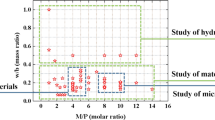Abstract
Basic Oxygen Furnace (BOF) dust is a secondary resource with high total iron (TFe) content produced in metallurgical steelmaking process. It is the most economical way to recycle BOF dust by adding binders to prepare cold-bonded pellets and returning to BOF for steelmaking. Nevertheless, the digestion reaction of dead-burned MgO and CaO contained in BOF dust causes expansion and cracking of the pellets. Based on the hydration mechanism of nonhydraulic cementitious materials, it was first proposed to use the dead-burned MgO contained in BOF dust as a binder raw material, mixed with MgCl2 or KH2PO4 to form magnesium oxychloride (MOC) or magnesium potassium phosphate (MKP) binder to prepare cold-bonded pellets, while simultaneously consuming MgO and reducing the expansion stress generated by digestion reaction. In this paper, a comparative analysis of strength and bonding mechanism of the two binders is carried out to lay the foundation theory for their rational application. The results show that MKP and MOC binders are beneficial to improve the early and later strength of pellets respectively. The acicular 5 phase crystals formed by MOC binder have strong surface polarity and high bonding strength. They are interlocked to generate a network structure, which forms a unified whole with high strength after the dust particles are wrapped; the prismatic K-Struvite crystals formed by MKP binder have strong intermolecular force and high binder self-strength. They are embedded in the gaps between the dust particles and form solid bridges to improve the pellet strength.












Similar content being viewed by others
References
A. Gritzan and D. Neuschütz: Steel Res., 2001, vol. 72, pp. 324-30.
F. Su, H.O. Lampinen and R. Robinson: ISIJ Int., 2004, vol. 44, pp. 770-76.
D.S. Kumar, R. Sah, V.R. Sekhar and S.C. Vishwanath: Ironmak. Steelmak., 2017, vol. 44, pp. 134-39.
J. Hou, Y. Lv, J. Liu and Q. Wu: Mater. Struct., 2018, vol. 51, p. 113.
E. Serris, L. Favergeon, M. Pijolat, M. Soustelle, P. Nortier, R.S. Gärtner and Z. Habib: Cem. Concr. Res., 2011, vol. 41, pp. 1078-84.
I.E. Doronin and A.G. Svyazhin: Metallurgist, 2012, vol. 55, pp. 879-86.
R. Jia and J. Liu: Adv. Mater. Sci. Eng., 2016, vol. 2016, pp. 1-15.
X. Li, P. Tang, X. Zhu, P. Qin and G. Wen: Metall. Mater. Trans. B, 2020, vol. 51, pp. 1016-26.
X. Li, P. Tang, P. He, X. Zhu and G. Wen: Metall. Mater. Trans. B, 2020, vol. 51, pp. 2400-12.
B. Tooper and L. Cartz: Nature, 1966, vol. 211, pp. 64-66.
B. Matkovic and J.F. Young: Nature, 1973, vol. 246, pp. 79-80.
C.K. Chau and Z. Li: Mater. Struct., 2008, vol. 41, pp. 853-62.
M.A. Haque and B. Chen: Constr. Build. Mater., 2019, vol. 211, pp. 885-98.
B. Xu, F. Winnefeld, J. Kaufmann and B. Lothenbach: Cem. Concr. Res., 2019, vol. 123, p. 105781.
M. Le Rouzic, T. Chaussadent, G. Platret and L. Stefan: Cem. Concr. Res., 2017, vol. 91, pp. 117-22.
Z. Li and C.K. Chau: Cem. Concr. Res., 2007, vol. 37, pp. 866-70.
Z. Liu, M. Balonis, J. Huang, A. Sha and G. Sant: J. Am. Ceram. Soc., 2017, vol. 100, pp. 3246-61.
B. Xu, H. Ma and Z. Li: Cem. Concr. Res., 2015, vol. 68, pp. 1-9.
B. Xu, B. Lothenbach, A. Leemann and F. Winnefeld: Cem. Concr. Res., 2018, vol. 108, pp. 140-51.
H. Lahalle, C.C.D. Coumes, C. Mercier, D. Lambertin, C. Cannes, S. Delpech and S. Gauffinet: Cem. Concr. Res., 2018, vol. 109, pp. 159-74.
G. Zhang, Y. Sun and Y. Xu: Renew. Sust. Energ. Rev., 2018, vol. 82, pp. 477-87.
M.E. Fayed and L. Otten: Handbook of Powder Science & Technology, Springer, Boston, MA, 1997, pp. 202–377.
D. Bika, G.I. Tardos, S. Panmai, L. Farber and J. Michaels: Powder Technol., 2005, vol. 150, pp. 104-16.
H.C. Hamaker: Phy., 1937, vol. 4, pp. 1058-72.
H.C.H. Rumpf: Chem. Ing. Tech., 1970, vol. 42, pp. 538-40.
K. Sugimoto, R.E. Dinnebier and T. Schlecht: Acta Crystallogr. Sect. B, 2007, vol. 63, pp. 805-11.
H. Bilinski, B. Matković, C. Mažuranić and T.B. Žunić: J. Am. Ceram. Soc., 1984, vol. 67, pp. 266-69.
M. Mathew and L.W. Schroeder: Acta Crystallogr. Sect. B, 1979, vol. 35, pp. 11-13.
G. Ferraris, H. Fuess and W. Joswig: Acta Crystallogr. Sect. B, 1986, vol. 42, pp. 253-58.
K. Sugimoto, R.E. Dinnebier and T. Schlecht: J. Appl. Crystallogr., 2006, vol. 39, pp. 739-44.
Acknowledgments
The authors are very grateful for support from the National Natural Science Foundation of China (Grant No. 51574050).
Author information
Authors and Affiliations
Corresponding author
Additional information
Publisher's Note
Springer Nature remains neutral with regard to jurisdictional claims in published maps and institutional affiliations.
Manuscript submitted October 8, 2020; accepted January 23, 2021.
Rights and permissions
About this article
Cite this article
Li, X., Tang, P., Fu, Q. et al. Strength and Bonding Mechanism of Nonhydraulic Cementitious Binders: Reutilization of MgO in Basic Oxygen Furnace Dust. Metall Mater Trans B 52, 1322–1332 (2021). https://doi.org/10.1007/s11663-021-02095-9
Received:
Accepted:
Published:
Issue Date:
DOI: https://doi.org/10.1007/s11663-021-02095-9




